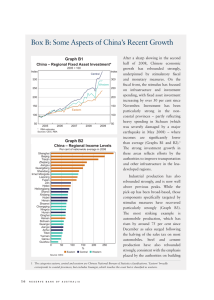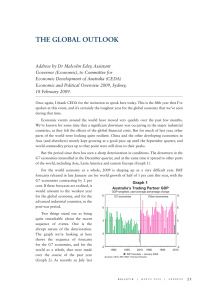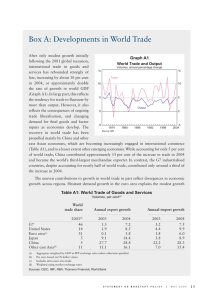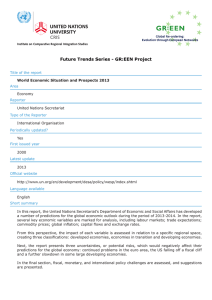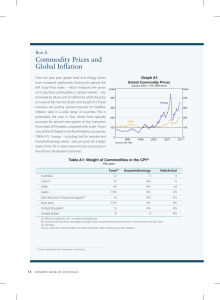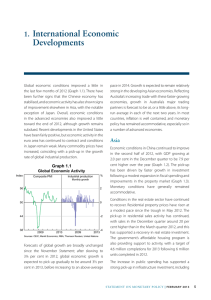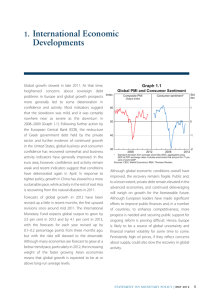Box A: Global Industrial Production Graph A1
advertisement
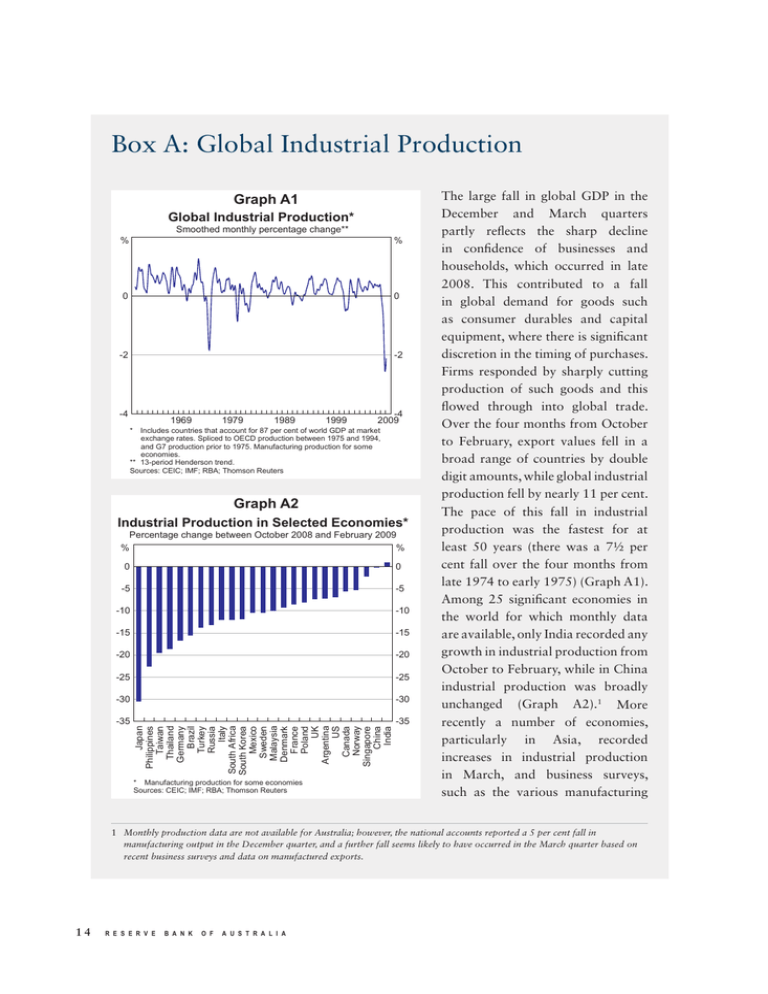
Box A: Global Industrial Production Graph A1 Global Industrial Production* Smoothed monthly percentage change** % % 0 0 -2 -2 -4 1969 1979 1989 1999 -4 2009 * Includes countries that account for 87 per cent of world GDP at market exchange rates. Spliced to OECD production between 1975 and 1994, and G7 production prior to 1975. Manufacturing production for some economies. ** 13-period Henderson trend. Sources: CEIC; IMF; RBA; Thomson Reuters Graph A2 Industrial Production in Selected Economies* % Percentage change between October 2008 and February 2009 % 0 -5 -5 -10 -10 -15 -15 -20 -20 -25 -25 -30 -30 -35 -35 Japan Philippines Taiwan Thailand Germany Brazil Turkey Russia Italy South Africa South Korea Mexico Sweden Malaysia Denmark France Poland UK Argentina US Canada Norway Singapore China India 0 * Manufacturing production for some economies Sources: CEIC; IMF; RBA; Thomson Reuters The large fall in global GDP in the December and March quarters partly reflects the sharp decline in confidence of businesses and households, which occurred in late 2008. This contributed to a fall in global demand for goods such as consumer durables and capital equipment, where there is significant discretion in the timing of purchases. Firms responded by sharply cutting production of such goods and this flowed through into global trade. Over the four months from October to February, export values fell in a broad range of countries by double digit amounts, while global industrial production fell by nearly 11 per cent. The pace of this fall in industrial production was the fastest for at least 50 years (there was a 7½ per cent fall over the four months from late 1974 to early 1975) (Graph A1). Among 25 significant economies in the world for which monthly data are available, only India recorded any growth in industrial production from October to February, while in China industrial production was broadly unchanged (Graph A2).1 More recently a number of economies, particularly in Asia, recorded increases in industrial production in March, and business surveys, such as the various manufacturing 1 Monthly production data are not available for Australia; however, the national accounts reported a 5 per cent fall in manufacturing output in the December quarter, and a further fall seems likely to have occurred in the March quarter based on recent business surveys and data on manufactured exports. 14 R e s e R v e b a n k o f a u s t R a l i a purchasing managers indices, suggest that the pace of contraction in global industrial production has begun to slow noticeably. As noted in the chapter, a key trigger for the decline in production appears to have been the acute falls in confidence associated with the collapse of Lehman Brothers in mid September 2008 and the intensification of the strains in the global financial system at that time. Tighter access to various forms of credit also seems to have been a factor in the decline in activity. For example, access to finance for participants in international trade has become more restricted in some regions, and is likely to have impinged on the global flow of goods and hence production. The largest falls in production have been for capital equipment and ‘big-ticket’ consumer durables (Graph A3). These are typically discretionary purchases that can be easily deferred by consumers and businesses in response to heightened concern Graph A3 about the economic outlook. The Industrial Production in Selected Economies* January 2008 = 100 lower demand for these goods has Index Index also flowed through to a sharp fall in demand for intermediate goods used in the production process. In Consumer non-durables 100 100 contrast, the decline in production of non-durable consumer goods, Capital goods** Intermediate such as food and beverages, has goods*** 80 80 been noticeably less pronounced. Consumer durables A good illustration of how demand for ‘big-ticket’ items 60 60 has been cut by consumers and M J S D M 2008 2009 businesses is the collapse in global * Euro area, Japan, South Korea, UK and US ** Business equipment for the US motor vehicle production. Sales of *** Business supplies and materials for the US; producer goods for Japan Sources: CEIC; IMF; RBA; Thomson Reuters cars in major developed economies in March this year were down by more than 25 per cent from the level at the end of 2007 (Graph A4). As a result, motor vehicle and parts production has also fallen abruptly. The extreme weakness in motor vehicle production has flowed through to sharp falls in the production of materials like steel, plastics and chemicals. Governments in several countries (including China and some European nations) have responded by introducing policies to spur demand for motor vehicles, and this appears to have recently resulted in higher car sales and production, particularly in China and Germany. In Germany, the government will provide €2 500 for any car that is nine years or older that is scrapped and replaced by a new car. Following the introduction of this scheme, which runs to the end of 2009, new car registrations increased by 50 per cent in February and March. However, car s t a t e m e n t o n m o n e t a R y P o l i c y | M A y 2 0 0 9 15 Graph A4 Car Sales in Major Developed Economies* Monthly sales have remained weak elsewhere in the developed world. At the country level, industrial production in Japan has been 3.5 3.5 particularly affected, declining by more than 30 per cent from October 3.0 3.0 to February and by nearly 40 per cent over the year. This has taken 2.5 2.5 the level of production in Japan 2.0 2.0 back to that last seen in 1983, and the contraction in GDP is expected 1.5 1.5 to be the largest among the major industrial countries. The fact that 1.0 1.0 1974 1981 1988 1995 2002 2009 Japan has been particularly hard-hit * Canada, euro area, Japan, UK and US; passenger cars only except for Canada and US by the current global downturn Sources: RBA; Thomson Reuters is consistent with the relative importance to the Japanese economy of high-value manufacturing of capital goods and consumer durables, such as cars. Nevertheless, more recently there have been some signs of stabilisation in industrial production in Japan with a small rise in March. R M 16 R e s e R v e M b a n k o f a u s t R a l i a
